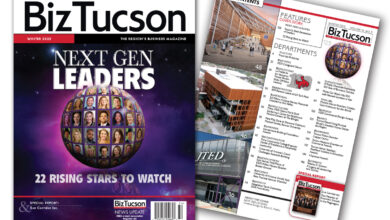
A Cathedral of Glass
Final Mirror Cast for Giant Magellan Telescope at UArizona
By Dave Perry
On Saturday, Oct. 7, the seventh and final required mirror for the Giant Magellan Telescope was cast at the Richard F. Caris Mirror Lab, under the east stands of Arizona Stadium.
It’s the 24th mirror cast overall in the lab’s 38-year history. And GMT No. 7 is a big one, both physically and historically, because it’s the last “petal” of what will be the largest, most advanced telescope ever built.
In 2030, or 2031, the Giant Magellan Telescope is slated to scan the skies from the Las Campanas Observatory in Chile, at an elevation of 7,874 feet above the very dark, very dry Atacama Desert.
The GMT will “revolutionize astronomy and our view of the universe,” according to UArizona literature. It will have a resolving power four times that of the James Webb Space Telescope, and 10 times the Hubble Space Telescope, both of which beam back never-before-seen images of the universe.
Its power is 50 million times that of your eye. Even when you’re wearing reading glasses.
“The telescope will make history through its future discoveries,” said Buell Jannuzi, director of Steward Observatory, head of the UArizona Department of Astronomy, and principal investigator for the fabrication of the GMT’s primary mirror segments. “We are thrilled to be closing in on another milestone toward completion of this groundbreaking observatory.”
Jannuzi calls the mirror fabrication a “modern cathedral building” … minus the stained glass. The GMT’s glass is perfectly crystal clear.
During the “high fire” event in early October, chunks of Japanese-manufactured optical glass (Ohara Corporation) totaling 20 tons were melted to the viscosity of cold honey, at a temperature of 2,130 degrees Fahrenheit, inside a 1-of-a-kind, 40-foot electric oven. It looks like a giant round waffle iron … except it spins like a top, so the mirror maintains its parabolic curvature.
And it keeps spinning, 24/7, slowing over time while the mirror cools. It’ll take three months of annealing for GMT No. 7 to reach room temperature, expected on Dec. 30. Once the lid is lifted, the mirror is ground and polished, to a surface accuracy of 1-millionth of an inch. Like the creation of any great cathedral, grinding, polishing, and testing will take years. UArizona has perfected the art.
“We produce the largest and most complex telescope mirrors in the world,” said Cathi Duncan, development and stewardship manager for UArizona’s Steward Observatory, and our enthusiastic, knowledgeable tour guide. “We know how to make large, lightweight mirrors. Nobody in the world does this.”
When finished, the mirror — about 2 inches thick, 2 stories tall on its edge, 27-1/2 feet in diameter and 80% hollow — will be taken by ship to Chile, where it’ll be placed with six other mirrors in a building yet to be constructed. By that time, institutions and private supporters will have invested $2.5 billion in it.
The GMT’s light-gathering power and image resolution should allow researchers to make new discoveries across all fields of astronomy.
“We will have a unique combination of capabilities for studying planets at high spatial and spectral resolution, both of which are key to determining if a planet has a rocky composition like our Earth,” said Rebecca Bernstein, the telescope’s chief scientist. Researchers can learn “whether it contains liquid water, and whether its atmosphere contains the right combination of molecules to indicate the presence of life.”
Carmala “Carmie” Garzione, UArizona professor of geosciences and dean of the College of Science, witnessed the seventh mirror pour. Even as a scientist, she asks … “how could anyone ever conceive of this? And how could we actually do it?’ Each step is a marvel, and a major accomplishment. It’s thrilling enough just seeing the process … in creating the world’s largest mirrors.”
“The Universe Awaits,” reads a sign in the UArizona mirror laboratory, and young astronomers anxiously await, too. With 400 incoming astronomy undergraduates newly enrolled at UArizona this Fall. The students are already talking about what exoplanets they’ll study a decade from now.
“It’s being built for the next generation of astronomers,” Duncan said.





